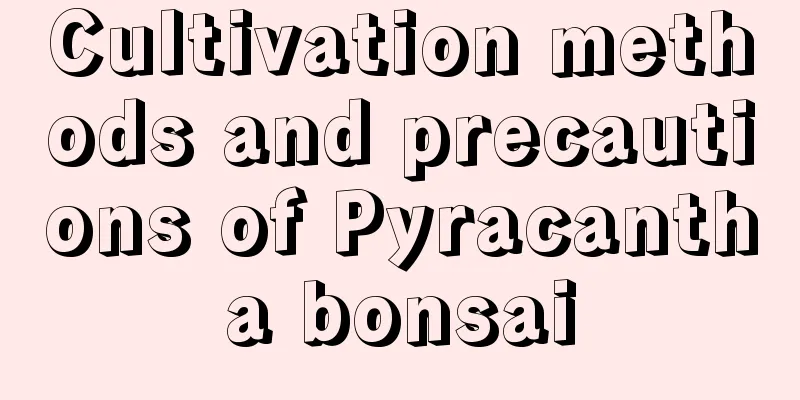Causes and treatments for yellow leaves of purple-leaf plum

1. Insufficient lightReason: Purple-leaf plum likes to grow in warm places, likes sunlight, and is not cold-resistant. Therefore, the place where purple-leaf plum grows needs to be kept in sufficient sunlight and the temperature should be maintained between 22 and 28 degrees Celsius. If there is insufficient light, it will cause yellow leaves problem. Measures: Purple-leaf plum must not be placed in a shady place without light. Only sufficient sunlight can promote its growth. Therefore, it needs to be placed in a sunny place such as a balcony, but be careful to avoid direct sunlight. 2. Moisture problemReason: Purple-leaf plum needs sufficient watering to grow, especially during its growing period, it needs to be watered in time. If you don't water it in time, you may have yellow leaves problems. However, during the rainy season in July and August every year, you can simply stop watering it and pay attention to drainage. If the roots rot, it will also cause the leaves to turn yellow. Measures: Pay attention to the growth status of the purple-leaf plum. If it is short of water, water it in time, control the amount, and not too thoroughly. If the purple-leaf plum has root rot problems during the rainy season, it should be pruned in time. 3. Improper fertilizationReason: Purple-leaf plum likes fertilizer, and sufficient fertilizer can promote its plant growth. If there is no fertilizer or insufficient fertilizer, it will have yellow leaves due to lack of nutrients. However, even if it likes fertilizer, you cannot apply too much fertilizer. Excessive fertilizer can easily burn the seedlings and cause yellow leaves. Measures: When fertilizing purple-leaf plum, you can apply an appropriate amount of fertilizer according to normal standards and use less chemical fertilizers. In late autumn, apply an appropriate amount of organic fertilizer. At the same time, pay attention to observation. If too much fertilizer is applied, stop fertilizing and immediately add water to dilute the fertilizer. 4. Soil issuesReason: Purple-leaf plum likes to grow in deep, fertile, acidic soil with good drainage. If the soil is too alkaline, dry, and has poor water storage performance, the root absorption capacity of purple-leaf plum will be reduced, resulting in yellow leaves. Measures: At this time, it is necessary to replace the soil with one that is slightly acidic, has a certain degree of fertility and is not easy to accumulate water. And during subsequent maintenance, change the soil every 1-2 years to ensure that the soil always meets its growth requirements. If it is a plant planted in the ground, you can consider lowering the pH value of the soil by watering it with ferrous sulfate solution to make it more suitable for the growth requirements of the plant. |
<<: Causes and treatments for yellow leaves of purple bamboo
>>: Causes and treatments of yellow leaves of purple bead grass
Recommend
Can taro seedlings be transplanted?
Can taro seedlings be transplanted? Taro seedling...
How to propagate the crabapple
Preparation before grafting The rootstock is chos...
Why did the asparagus fern turn yellow?
1. The reason for yellowing 1. Too much water wil...
How to grow water poppy
1. Water quality selection It is usually cultivat...
How to prune Dragon Wing Begonia? Pruning time and shaping methods
Dragon Wing Begonia Pruning Time To prune the Dra...
Are mulberries a fruit or a vegetable?
Are mulberries a fruit or a vegetable? Mulberry i...
How to deal with succulent plants that grow taller
1. Beheading If succulents grow too tall, you can...
Are you still complaining that your bougainvillea isn’t blooming? Do these things well and your flowers will bloom all year round!
Reasons why bougainvillea does not bloom The key ...
What flowers are suitable for growing in Longyan? What are the city flowers and trees?
1. Climate characteristics of Longyan Longyan has...
The value and flower language of snake eye chrysanthemum
The value and flower language of snake eye chrysa...
When is the best time to plant camellia?
Camellia is a flower plant with large flowers. It...
What fruits are suitable for planting in Jiangxi? What fruits are mainly produced?
Jiangxi is rich in fruits Jiangxi has a superior ...
Durian potted planting methods and techniques
The best time to plant potted durian is in spring...
Purple Magnolia Planting Methods and Precautions
Purple magnolia, also known as magnolia, is loved...
How to judge whether it is time to water the black orchid? The correct way to water it
Molan is also a type of orchid, and it is named b...









